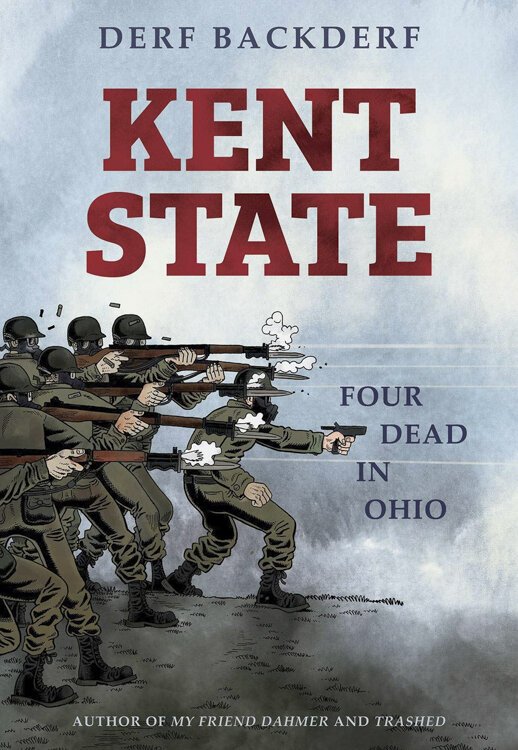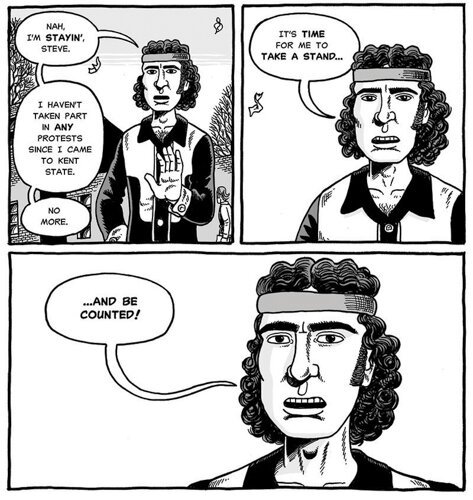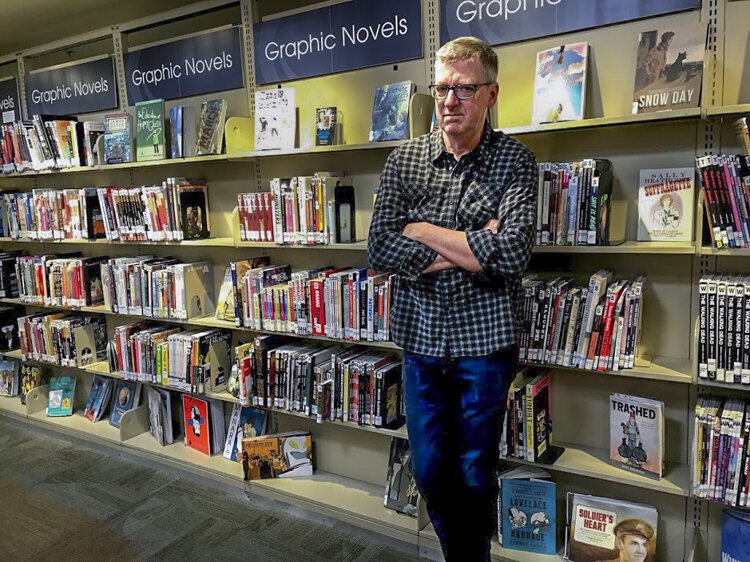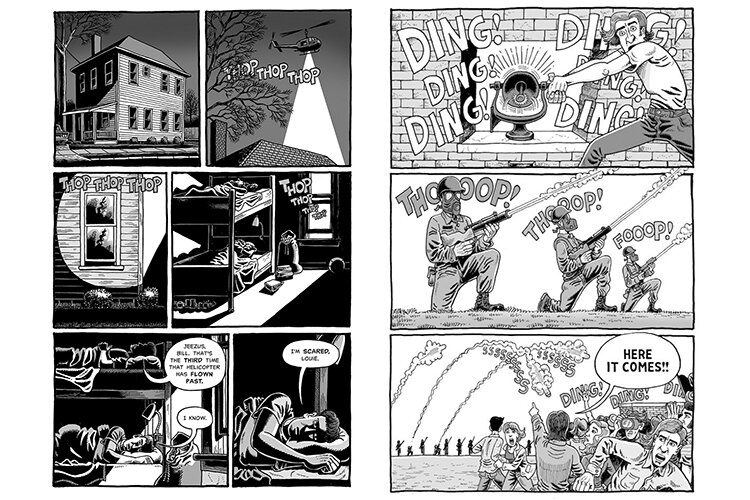Derf's new graphic novel ‘Kent State’ takes on tragic shooting
Derfology
1959: Derf is born in Richfield, Ohio, on Halloween.
1978: Graduates from Revere High School. Attends the Art Institute of Pittsburgh for a year.
1979: Gainfully employed as a garbage man.
Early 1980s: Political cartoonist for the Ohio State Lantern while attending Ohio State University.
1983: Graduates from OSU in the spring.
Mid-1980s: Political cartoonist for The Evening Times in West Palm Beach, FL.
1986: Derf returns to Ohio.
Late 1980s: Staff cartoonist at The Plain Dealer.
1990: Debuts “The City” comic strip at alt-weekly The Cleveland Edition. It spreads to 174 publications nationwide.
Mid-1990s: Works for The Akron Beacon Journal. Part of the newsroom team that wins the Pulitzer Prize in 1995.
1999: The Akron Art Museum presents a retrospective of Derf’s work, titled "Apocalyptic Giggles: The Industrial Cartoon Humor of Derf."
2006: Wins Robert F. Kennedy Journalism Award for cartooning.
2010: “Punk Rock & Trailer Parks,” a 152-page graphic novel.
2011: Ohio State University creates a Derf Collection of original art and papers.
2012: “My Friend Dahmer,” a 224-page graphic novel. Time Magazine names it one of the top five nonfiction books of the year.
2014: Derf discontinues “The City.” Wins the Prix Révélation at the Angouleme International Comics Festival in France.
2015: “Trashed,” a 240-page graphic novel.
2016: Wins an Eisner Award for lettering in “Trashed.”
2017: Film adaptation of “My Friend Dahmer” is released in theaters.
March 17, 2020: A gallery exhibit of “Kent State: Four Dead in Ohio” is set to open at the historic Society of Illustrators in New York City through June 13. Original pages, pencil pages and thumbnails by Derf will be on display.
April 7, 2020: Release date for “Kent State: Four Dead in Ohio.”
-- Chris Ball
Derf Backderf’s new graphic novel tackles a tragedy that still haunts Northeast Ohio. “Kent State: Four Dead in Ohio” comes out April 7, timed for the 50th anniversary of the terrible day when National Guardsmen fired upon unarmed college students. It’s a gutsy choice for the Shaker Heights illustrator, whose influences range from Monty Python and the National Lampoon to the Ramones. His true-crime memoir “My Friend Dahmer,” about attending high school with future serial killer Jeffrey Dahmer, was turned into a 2017 art-house movie. We caught up with Derf recently, a day before he embarked on a two-week European book tour.
You were 10 years old on May 4, 1970. What do you remember about how you spent that terrible day?
Well, I was a paperboy for the Akron Beacon Journal, which was an afternoon paper. So I remember the next day going to the dropoff box and opening it up and seeing that headline, “Four dead,” and then learning that it was the same Guardsmen who had been in my hometown [Richfield] for the Teamsters strike. That's what really hit home, and hearing the adults talking about it, and whispered voices here and there, it was the topic certainly in this area for a week or more, and it definitely sparked something in me and got me much more interested in what was happening in the world around me. And that just kept building as I became a teenager and then off to college and on and on. Really, it could have been anything, but it was Kent State that sparked that leap forward. And that's why I've carried this story with me all those years.
 With “Kent State,” as with “My Friend Dahmer,” you tell the story before the story. Why did you choose the last four days of the four students who were fatally gunned down?
With “Kent State,” as with “My Friend Dahmer,” you tell the story before the story. Why did you choose the last four days of the four students who were fatally gunned down?
When you sit down to write a book, you have to decide what it's about. And I decided to focus specifically on those four and show it through their eyes and their experiences. Because I wanted it to be personal, and I wanted it to be emotional, especially when you get to know these kids, know their hopes, dreams, fears, how they spend their days, and then they're cut down. I mean, it really packs a wallop at the end. So that was my intention. It could have very easily been an 800-page book, it's a very long, complex story, but I couldn't do that. So I narrowed the focus down as much as I could. It's still 250 pages. It's substantial.
Is this a clear case of justice denied?
Oh, absolutely. They got away with it, the shooters.There's so many villains in this story, certainly the politicians who are concerned about nothing but their own careers, especially [James] Rhodes, the governor, and the shooters themselves, who were actually a very small group, eight to 10 Guardsmen. Only they know why they opened fire, and because they've hidden behind an absolute wall of silence since, it certainly doesn't pass the smell test. They're hiding something, probably that they had decided beforehand, at some point during that day, to strike back at the students who were tormenting them, and they screwed it up, and they fired into a parking lot full of kids, most of whom had nothing to do with the protest. And then it was just a wall of lies. I mean, when the first 10 things coming out of the Guard officially are lies, why would you believe anything they say? But because of the politics of the day, much as the politics of today, there was a large majority of the American public who were happy to believe those lies.
What is the early buzz on “Kent State”?
It’s been pretty great. A lot of the industry, you know, magazines like Publishers Weekly, Library Journal, are writing about it, giving it glowing reviews. That's nice. People seem to be talking about it. We'll see. It's still pretty early.
Are the crazies starting to come out of the woodwork?
Not too many. I've already gotten a couple threatening letters. When it was first announced, some people wrote, “You’d better do this or better do that” or started ranting immediately. I’m not too worried about it. Everything's a fight now. And this is a fight that has been going on for 50 years, and we’ve still got old geezers out there who are making the same arguments.
An undercurrent of sardonic Rust Belt wit runs through your works, “The City,” “Trashed,” and “My Friend Dahmer,” all of which benefit from your first-person perspective. Are you able to maintain your trademark tone with the deadly serious subject matter of “Kent State”?
Well, no, this isn't a first-person account. This is a different book. I try to mix it up. I mean, my first book, “Punk Rock & Trailer Parks,” was fiction, it wasn't memoir or anything like that. So I don't think “My Friend Dahmer” is particularly sardonic, more reflective than anything. “Trashed” is certainly sardonic. But no, I don't think so. It's pretty straightforward. I let the four do most of the talking here.
You went from creating a nationally syndicated comic strip every week for more than a decade to producing a long-form graphic novel every three or four years. How do you keep your creative juices sharp without weekly deadlines?
It's a different process. But it's such a vast amount of work, I spent four years making this book, that even though I don't have something in print every week, I'm still working every day, working harder than I did on these books than I did on the strip, which was actually fairly easy to do. You’ve just got to readjust your brain to thinking long term rather than short term. It really wasn't that hard. I was pretty done with comic strips by the time I finally shut it down.
You spent two years doing research and interviews. Were you mainly in Kent?
Interviews are Skype and phone and things like that. A lot of the May 4 archive, which is Kent State's collection, is online, you’ve just got to find it on their site, which is not all that easy. So it was a mix. I did go down to Kent a lot. It's important to go down there physically and just walk around and put yourself in those scenes, in that space, so you can kind of take it in with all your senses working and maybe pull something away that you can put into the drawing or the story. So I did that numerous times. There are all kinds of scenes in the book that came from that experience.
 Excerpt from Kent State: Four Dead in OhioWould you have been able to embark on such a lengthy, ambitious project without the success of “My Friend Dahmer” and “Trashed”?
Excerpt from Kent State: Four Dead in OhioWould you have been able to embark on such a lengthy, ambitious project without the success of “My Friend Dahmer” and “Trashed”?
One book leads into another. I certainly didn't have the tools, particularly the drawing tools, to pull this book off before now. I needed to do those three previous books just to attain the skills that I needed. It is skill building. As a book creator, I'm fairly young, even though I'm an old workhorse, by any definition. I’ve only been doing books since 2010. So I do have a lot to learn, and it's been fun.
Fellini began his career as an illustrator. Storyboarding has overtaken screenwriting. Do you want to direct?
No. I make comics. Having been involved with a film, I have no idea how anyone gets anything done. There's so many balls in the air. There's so much to the financing and all the complexities of getting a film to the theater. It just seems like pure dumb luck. It took five years for my filmmakers to get “My Friend Dahmer” done. And they know what they're doing. So no, thanks.
Has society learned anything in the half-century since Kent State, or are we just repeating our mistakes?
It sure looks it, like we've circled right back around to 1970 in many ways. The only difference is the enraged protesters are all online screaming at each other rather than in the streets, but that could change at any moment. I think we're depressingly close to another Kent State. So this is a cautionary tale more than anything. If you threaten those in power, the price of dissent can be very high.
What's next for the artist known as Derf?
Another book. I'll be promoting this one for most of the year, and then I'll sit down and figure out what to do next, but I don't think that far ahead.
Derf’s comments have been lightly edited for readability.
See FreshWater Cleveland’s 2016 interview with Derf here.



